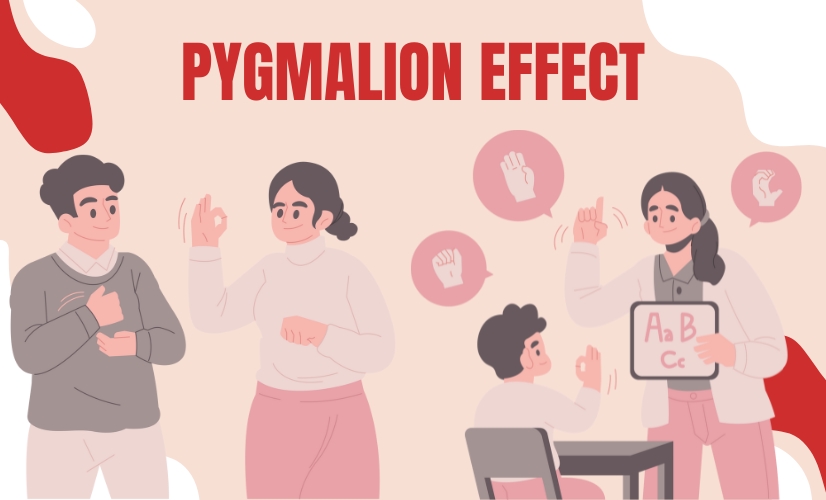The Pygmalion Effect, a phenomenon named after a mythological figure, plays a pivotal role in understanding how expectations influence outcomes. This psychological phenomenon suggests how people improve their performance when more is expected of them. This article explores the origins, implications, and applications of the Pygmalion effect to gain a deeper understanding of how it can be harnessed to improve educational, professional, and therapeutic environments.
What is the Pygmalion Effect?
The Pygmalion Effect, or the Rosenthal Effect is rooted in the concept of how one individual’s expectations can positively impact the behavior of another. In other words, a person can influence another in such a way that that the expectations are realized. It believes how people tend to perform better when more is expected of them, and conversely, they may underperform when expectations are low.
Concept and Origins of the Pygmalion Effect
The Pygmalion Effect derives its name from the Greek myth of Pygmalion, a sculptor who fell in love with a statue he had carved. According to the myth, Pygmalion’s unwavering belief and love for the statue brought it to life. This story was adapted into various forms, including George Bernard Shaw’s play “Pygmalion” and the musical “My Fair Lady.” The effect gained prominence after a landmark study by psychologists Robert Rosenthal and Lenore Jacobson in the late 1960s.
How Does it Affect People?
The Pygmalion Effect impacts individuals in various ways, often based on the context in which the expectations are set. Here are some key areas where the effect is evident:
- Academic Performance: In educational settings, a teachers’ expectation can influence students’ academic achievements. When teachers expect more from certain students, they are more attentive, encouraged, confident and perform well.
- Workplace Productivity: In the workplace, managers’ expectations can affect employees’ productivity and job satisfaction. High performing employees often receive more opportunities for growth, positive feedback, and challenging assignments, which can lead to efficiency, performance, and career growth.
- Personal Relationships: In personal relationships, positive expectations from family members or partners can boost an individual’s self-esteem and encourage them to achieve their goals. Conversely, negative expectations can undermine confidence and lead to poor performance.
Why is it Important?
Understanding how expectations impact behavior is crucial for achieving the best possible outcomes. The Pygmalion effect illustrates that positive expectations can lead to better performance, as seen when teachers gave more attention and encouragement to students labeled as “bloomers.” Therefore, maintaining positive expectations can motivate individuals to meet those expectations. However, it’s essential to avoid favoritism, as it can demotivate others and reduce overall productivity. Balancing our expectations ensures fairness and maximizes the potential of everyone involved.
How to Use the Pygmalion Effect
Harnessing the Pygmalion Effect involves setting high, yet realistic, expectations and providing the necessary support to achieve them.
Here are some strategies to effectively use this phenomenon:
Positive Reinforcement: Consistently offering positive reinforcement, acknowledging efforts, celebrating small wins, and encouraging continuous improvement, helps individuals recognize their potential and strive for excellence
Setting Clear Goals: When individuals know what is expected of them and understand the path to achieving it, they are more likely to stay focused and committed.
Providing Support and Resources: Ensuring that individuals have access to the necessary resources, training, and support systems is crucial. This might include mentoring, coaching, or providing additional learning materials to help them succeed.
Creating a Positive Environment: Fostering a positive and supportive environment where individuals feel valued and respected can enhance their motivation and performance. This includes promoting open communication, collaboration, and a culture of mutual respect.
How to Avoid Negative Effects
While the Pygmalion Effect can be beneficial, negative expectations can lead to detrimental outcomes. Here are ways to avoid the negative effects:
- Avoiding Biases: It is important to recognize and mitigate biases that can lead to low expectations for certain individuals. This requires self-awareness and a commitment to treating everyone fairly and equitably.
- Focusing on Strengths: Highlighting and building on individuals’ strengths rather than focusing on their weaknesses can boost their confidence and performance. This involves identifying and leveraging their unique talents and abilities.
- Continuous Assessment and Feedback: Regularly assessing performance and providing constructive feedback helps individuals stay on track and make necessary improvements. This should be done in a supportive and non-judgmental manner.
- Encouraging Growth Mindset: Promoting a growth mindset, where individuals believe that their abilities can be developed through hard work and dedication, can counteract the negative effects of low expectations. This involves encouraging resilience and perseverance in the face of challenges.
How it Affects Students’ Engagement
Student engagement is critical for academic success, and the Pygmalion Effect plays a significant role in this area. When teachers have high expectations, students are more likely to be engaged, motivated, and actively participate in their learning process. Here’s how:
Increased Motivation: High expectations can increase student’s intrinsic motivation to learn and achieve. When students feel that their teachers believe in their abilities, they are more likely to take ownership of their learning and strive to meet those expectations.
Enhanced Self-Esteem: Positive expectations can boost student’s self-esteem and self-efficacy. When students believe that they can achieve their goals, they are more likely to put in the effort and persist through challenges.
Better Academic Outcomes: Engaged students tend to perform better academically. They are more likely to complete assignments, participate in class discussions, and seek help when needed. This leads to better grades and a deeper understanding of the subject matter.
Positive Classroom Environment: High expectations contribute to a positive classroom environment where students feel supported and valued. This encourages collaboration, respect, and a sense of community among students.
Using the Pygmalion Effect, teachers can create a supportive and encouraging environment, free from biases and preconceptions. Focus on unleashing each student’s potential, empower students to become confident learners and reach their full potential.
The Pygmalion Effect in Therapy
The Pygmalion Effect can also be leveraged in therapeutic settings to promote positive outcomes for clients. Here’s how therapists can use this phenomenon:
Building Trust and Rapport
Establishing a trusting relationship is crucial in therapy. When clients feel that their therapist believes in their ability to change and improve, they are more likely to engage in the therapeutic process and work towards their goals.
Setting Realistic and Achievable Goals
Therapists can help clients set realistic and achievable goals, providing a clear path to success. This involves collaboratively identifying areas for improvement and developing a step-by-step plan to address them.
Positive Reinforcement and Encouragement
Consistently offering positive reinforcement and encouragement can boost clients’ confidence and motivation. This includes acknowledging progress, celebrating successes, and providing constructive feedback.
Fostering a Growth Mindset
Encouraging clients to adopt a growth mindset in therapy can help them overcome obstacles and develop resilience. This involves helping them reframe negative thoughts and beliefs about their abilities and focusing on their potential for growth and change.
Therapists as leaders with expectations for their patients, can significantly influence outcomes. Believing in a patient’s success and adopting a positive and supportive environment, enhances the patient’s chances of success. Therefore, therapists should maintain high expectations to help patients achieve their therapeutic goals.
Conclusion
The Pygmalion Effect is a powerful psychological phenomenon that highlights the significant impact of expectations on performance and behavior. By understanding its origins, mechanisms, and implications, it can be harnessed to achieve positive results while neutralizing negative effects. Whether in educational settings, workplaces, personal relationships, or therapeutic environments, setting high expectations and providing the necessary support help create environments where individuals can thrive and reach their full potential.





